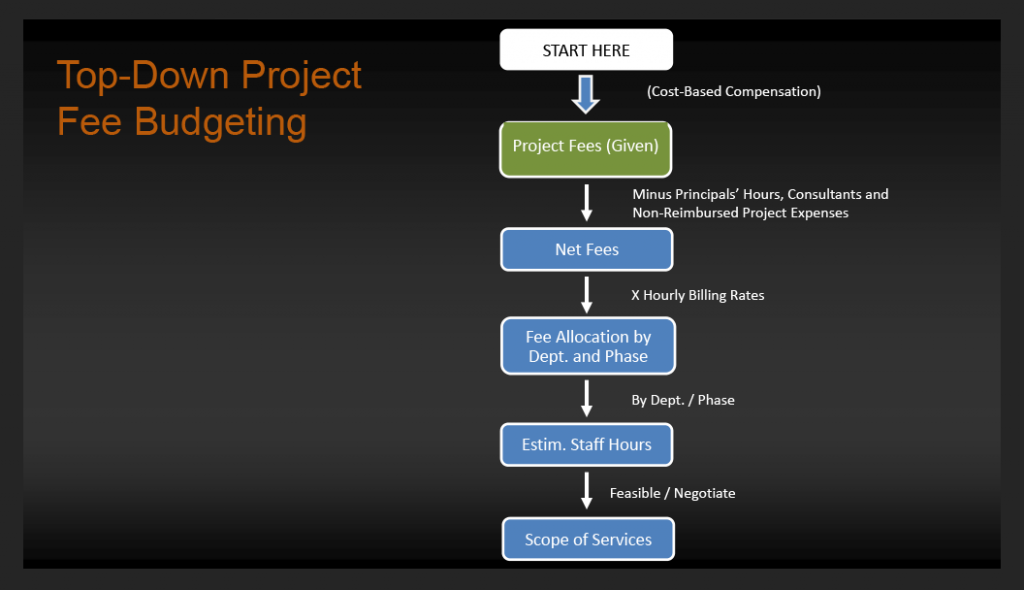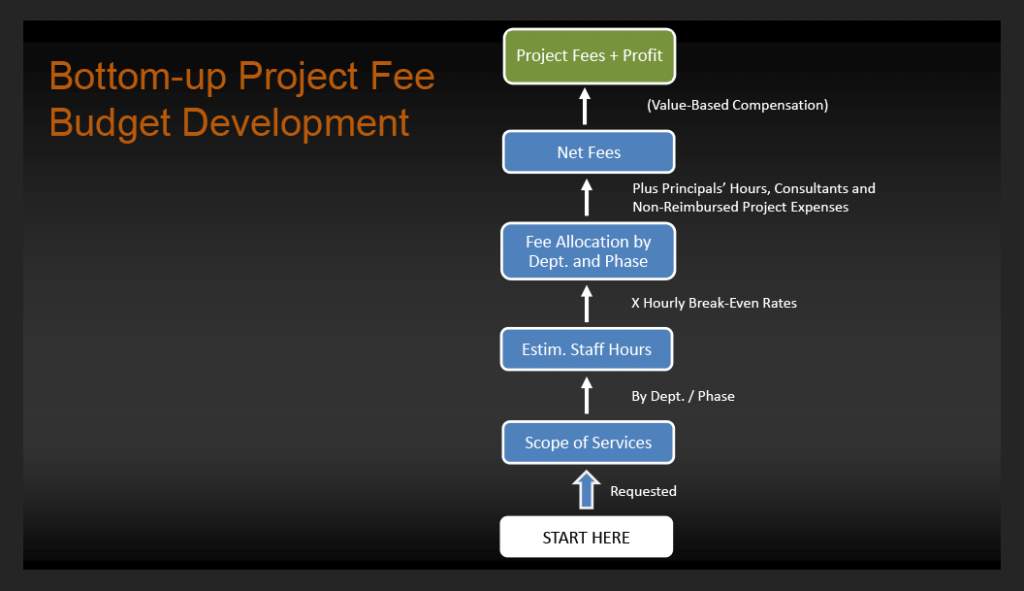Project Fee Budgeting for Architects
Sadly, there’s no way for an architect to guarantee their projects will be profitable, let alone earn a minimum 20% Net Profit at the completion of any project. There are however ‘best practices’ to apply to ensure that a project is profitable and to even successfully earn a minimum Net Profit of 20%.
In my professional opinion, one of the best practices to apply in advance of providing a client with a proposed fee is to always invest the time and expense required to develop a Project Fee Budget. My preferred best practice method for developing a project fee is the “Top-Down, Bottom Up” approach to fee budgeting. Applying these two approaches, I believe, is as close an architect can hope to create as a ‘guarantee’ of a minimum 20% Net Profit at the end of any project.
The step-by-step process for applying the Top-Down method is as follows:
Top-Down Project Fee Budgeting
This method is primarily for any public sector proposed project (e.g.: government agencies) where the client sets the fee by establishing a stipulated construction cost budget and a percentage of that budget to establish the architect’s fee.
This method is applied to ensure that, if selected, the Firm has an opportunity to earn the minimum 20% Net Profit. It might seem that with the client setting the parameters for the architect’s fee that the Firm has few, if any options, to be able to negotiate what has been offered. To a degree that is true, but not completely.
Using the attached Fig.1-Top-Down graphic as a guide and going through each of the incremental steps that follow below, the Firm can determine if the hours established are sufficient to fully deliver the scope of services identified in the client’s Request for Proposal (RFP), and if the Stipulated Lump Sum Fee (SLSF) is feasible for earning the desired minimum 20% Net Profit.
Step One, per Fig.1, is to determine the number of hours to be allocated for the involvement of the Principal-in-Charge (PIC) and the related dollar portion of the SLSF. The reason the number of hours and dollars need to be allocated is to allow their subtraction from the SLSF to establish a ‘Net Fee’ to be managed by the selected Project Manager (PM).
It is not appropriate to expect a PM to manage the time and involvement of the PIC. It is however, appropriate for the PIC to be responsible for managing their own hours and fee dollars, as agreed upon, for their involvement in the project and to assist the PM throughout the project.
Step Two entails the calculation of hours and dollars needed to provide the scope of services, outlined in the RFP, for the Firm and its outside project consultants (O-C) to determine if the Net Fee is sufficient to complete the proposed project for the client-provided SLSF.
Before developing the project fee budget for the Firm, the Net Fee will need to be reduced by the total fee amount required for selected O-C’s, and the calculated cost of the Firm’s non-reimbursable project expenses (NRPE), to determine the Firm’s portion of the fee.
The preferred method of establishing the fee amounts for each of the O-C’s would require the PM to prepare an RFP for each consultant, based on the client-provided project program and scope of services. These RFP’s will ask for a proposed Lump Sum Fee (LSF) from each O-C. The proposed LSF’s would then be ‘negotiated’ (to ensure the total these fees will be in the 25-30% range of the SLSF) with each of the O-C’s by the PM, with the involvement of the PIC. The total of the O-C fees and the Firm’s own calculated NRPE (a range of 12-15% of SLSF) would reduce the Net Fee to establish the Firm’s portion of the SLSF for completing the proposed project.
Step Three involves calculating the number of dollars to be allocated to each of the project phases, per the scope of services. With the phase fees established, the number of hours to be allocated to each phase of the project can then be calculated (preferably) by dividing each phase fee by the hourly billing rate for each member of the project team, for each phase. CAVEAT: All of the hourly billing rates need to be based on the Firm’s calculated overhead rate and include a minimum 20% Net Profit. NOTE: Any short-cut to this method will render the value and purpose of this undertaking – just don’t bother, accept what you get, or do it your own way.
This set of calculations will then establish the Firm’s fee required to complete the scope of services for the proposed project.
The following is a hypothetical example of what all this might look like:
Assumptions:
- Stipulated Lump Sum Fee (SLSF) given is $700,000.
- PIC allocated fee is $60,000 (assume: 12% x Firm’s Fee of $500,000)
- Total O-C Fee is $200,000 (approx. 28.5% of $700,000)
- NRPE is $87,500 (12.5% of $700,000)
- Firm’s Portion of SLSF is $500,000 ($700,000-$200,000)
- Net Fee for Project Phases is $352,500 ($500,000 – $60,000 – $87,500)
Using this hypothetical example, the following are three possible scenarios that might result. Each one will determine the firm’s next step(s) in accepting, rejecting or negotiating the SLSF with the client.
The three possible scenarios are:
- The calculated fee will confirm that the SLSF is capable of supporting the RFP scope of services and allow for the potential to earn a minimum 20% Net Profit.
Action: Obvious (but, least likely)…accept the proposed fee and scope of services. Recommendation: I would first seek to reduce the scope as suggested in the Alternative Action for Scenario #2 below. - The calculated fee will confirm that the SLSF is not capable of supporting the RFP scope of services and a minimum 20% Net Profit.
Action: Reject the proposed fee outright, “thanks, but no thanks” (not wise).
Alternative: That the calculations don’t support the SLSF for the proposed scope of services begs the question: “Is the client willing to negotiate the RFP scope of services”? Since client is not likely to negotiate the SLSF, go for modifying the scope of services. This will require a thorough review of the scope of services by the PM & PIC to identify areas for scope reduction to reduce the Firm’s hours & fee and possibly make the SLSF feasible.
HINT: The first place to look for possible reductions in scope is to identify any vague contract language that is ‘open-ended’. Examples would include: not specifically identifying the number of meetings in each phase, the number of design options in the SD &DD phases, and the specific number of visits to the site during the CA phase. In far too many contracts a client will not specify or limit these time-consuming activities. They use vague terms, subject to interpretation (e.g.; “meetings as required”, or “periodic site visits”). These are open-ended ‘traps’ that waste hours and fee, which is inappropriate. - The calculated fee will confirm that the SLSF is NOT capable of supporting the RFP scope of services or a minimum 20% Net Profit. HOWEVER, the PIC could decide that the amount of potential profit would be high enough for the Firm to accept the proposed SLSF in the RFP.
Action: Obvious…but again, I would first seek to reduce the scope as suggested in the Alternative Action for Scenario #2 above.
Once it is known which scenario best defines the feasibility of the SLSF, and the preferred action required is agreed upon, the next step is communication with the client.
It is my professional recommendation that if the Firm decides to submit a response to the RFP, that it only be done by the PIC and PM in a face-to-face meeting with the client. Never send a fee proposal to a client until there has been this meeting to discuss and negotiate your project fee proposal.
It will be in this meeting with the client that the discussion of their willingness to appropriately reduce the scope of services will be raised; without eliminating any critical aspects of the required scope, or reducing the client’s proposed SLSF.
Step Four is the last step before such a meeting takes place. The PM, with input from the PIC, will prepare the documentation & calculations necessary to successfully negotiate a ‘win-win’ outcome. ‘Win-win’, in this instance, is defined as both parties agreeing on the final outcome. This might include the firm choosing to not accept any offers made by the client because it knows, going into the negotiation, what the Firm’s Breakeven Cost is to complete the scope of services required and the resulting Net Profit percentage is unacceptable. This would then be a “Thanks, but no thanks” response to the final offer. To accept such an inadequate fee and profit percentage is tantamount to the first step on a path to bankruptcy. Rejection in this instance, is a ‘win’ for the Firm. It allows for a new opportunity, and a better match with a client. The client also ‘wins’ in not having to deal with a disgruntled Firm.
So, Step Four involves the calculation of the Firm’s Breakeven Cost to deliver the proposed project. This will require knowing the Firm’s Overhead Rate (OR), which can be calculated (from the accrual Profit/Loss Statement (P/L): Total Indirect Labor & Expenses divided by Total Direct Labor. The Breakeven Rate (NOT Cost), is the OR + 1.00 (unit for Direct Salaries). The Breakeven Cost is the total of the dollar amounts on the accrual P/L for Total Direct Labor and Total Indirect Labor & Expenses.
Hypothetical Example (from the Firm’s latest approved, accrual P/L):
Assumptions:
- Net Operating Revenue (NOR): $1,500,000
- Total Direct Labor (TDL): $450,000 (in a range of 28 to 32% of NOR)
- Total Salaries: $650,000 ($450,000 Direct +$200,000 Indirect)
- Total Ind. Labor & Expenses (TIE): $690,000 (assume 46% of NOR)
- Overhead Rate (OR): 1.46 (TIE/TDL) (a range of 1.30 to 1.50 of TDL)
- Overhead Cost (OR Cost): $690,000 ($200,000 + $490,000)
- Breakeven Rate (B-E): 2.46 (OR + 1.00 as a unit of Direct Salaries)
- Breakeven Cost (B-E Cost): $1,140,000 (TIE: $690,000+TDL: $450,000)
- Total Misc. Revenue & Expense MR&E): $60,000 (4-6% of NOR)
- Net Profit % (NP): 20% (NOR – B-E Cost- MR&E/NOR)
- Net Profit $ (NP): $300,000 (NOR – B-E Cost – MR&E)
With knowledge of the Firm’s B-E Rate and Cost, the B-E hourly rates of each project team member can be calculated and their respective cost to each phase of the project can also be calculated. If the above metrics were applied to the assumed SLSF of $700,000, and the firm’s portion of the fee is $412,500 and a B-E Cost of 76% ($1,140,000/$1,500,00), less MR&E, the Net Profit % would be 20%.
On this basis, it appears the proposed SLSF is feasible and it would be possible for the Firm to complete the proposed project and earn a potential 20% Net Profit.
To check the results you have calculated, it is my recommendation that the Firm use the Bottom-Up method to establish what the fee would be if they were asked to submit a proposed Total Lump Sum Fee (TLSF) based on the same scope of services provided in the RFP (to compare with the hypothetical $700,000 SLSF).
Bottom-Up Project Fee Budgeting
This method is used primarily for developing a proposed fee for a client once the project program requirements and the scope of services are defined.
Using the Bottom-Up Fig.2 graphic as a guide, go through each of the following incremental steps to establish the Breakeven Cost for the scope of services and then calculate the minimum 20% Net Profit, to determine the proposed TLSF, that includes the fees for the PIC involvement, the O-C LS Fees, and the Firm’s NRPE.
Step One starts with an analysis of the scope of services to eliminate any vague quantification for design option, project phase meetings and/or CA site visits. These are to be replaced with a specific quantity for each of these types of scope items.
Step Two will require determining the project team hours to be allocated for each phase of the project.
Step Three will be the calculation of the Firm’s proposed B-E Cost, using the B-E hourly rates for each respective project team member, multiplied by the number of calculated hours for each team member, for each project phase. This series of calculations will define the Net Fee, before including the B-E Cost for the PIC’s agreed upon hours, the total of the O-C LS Fees, and the B-E Cost of the Firm’s NRPE. This will be the proposed TLSF, excluding the Firm’s minimum 20% Net Profit.
Step Four will involve the following method to calculate the minimum 20% Net Profit to be included in the proposed TLSF.
With the now established TLSF, exclusive of any profit, the 20% minimum Net Profit to be added to get the full proposed TLSF is calculated by dividing the ‘established TLSF’ (that does not include the net profit) by 80% (the complement of the 20% NP).
Example:
Assuming the Bottom-Up calculation for the B-E Cost of the TLSF, exclusive only of the Net Profit, is $550,000, the calculation for the full TLSF, including a minimum 20% Net Profit would be $550,000 divided by 80% = $687,500. To verify the Net Profit included, subtract the B-E Cost for the TLSF from the full TLSF: $687,500 – $550,000 = $137,500, which is 20% of $687,500.
These calculations would affirm that the proposed SLSF in the RFP would allow the Firm to deliver the proposed project and earn the potential minimum 20% Net Profit.
 This is a guest post written by Steve L. Wintner, AIA, Emeritus, an architecture management consultant and co-author of the book, Financial Management for Design Professionals: The Path to Profitability
This is a guest post written by Steve L. Wintner, AIA, Emeritus, an architecture management consultant and co-author of the book, Financial Management for Design Professionals: The Path to Profitability (watch for an updated edition coming soon). To learn more about Steve, his firm Management Consulting Services or to dive deeper into the subject that Steve is sharing with us here at EntreArchitect, visit his website at ManagementConsultingServices.com.



Mark and Steve, thanks for publishing this article! This is valuable and so necessary for all design offices. We will be using this formula at our office to determine our firms status in each phase of our projects. Do you have any additional resources? Im building a template excel spreadsheet to breakdown all the numbers and plan to use it for determining status for different teams within our studio. Thanks for sharing!
Henry, thank you for your kind words and acknowledgement. I would be pleased to share with you other documents that might be helpful in your development of an Excel template for use with determining project team status.
I wish you every success in your endeavor.
Regards,
Steve
I’m currently preparing for the Construction Evaluation ARE exam. Could not make complete sense of the Top-Down and Bottom-Up budgeting sections in the Professional Practice Handbook.
After reading your post, it all makes complete sense now. Thanks so much a clear a defined explanation.
Marc, my apologies for not responding sooner. Usually i get a notice from EA of comments posted on the Blog for my articles. I never knew until just now that you had added your comment.
I am sorry the Handbook explanation was not clear. I had limited space to write what was necessary. I am however, pleased this explanation on the EA Blog made it all clear for you.
I invite you to contact me at my business email address, slwintner@managementconsultingservices.com) at anytime you need further clarification or have questions and comments I can answer or provide a response.
I wish you well as we prepare to start the new year, ‘on the right foot’.
Best,